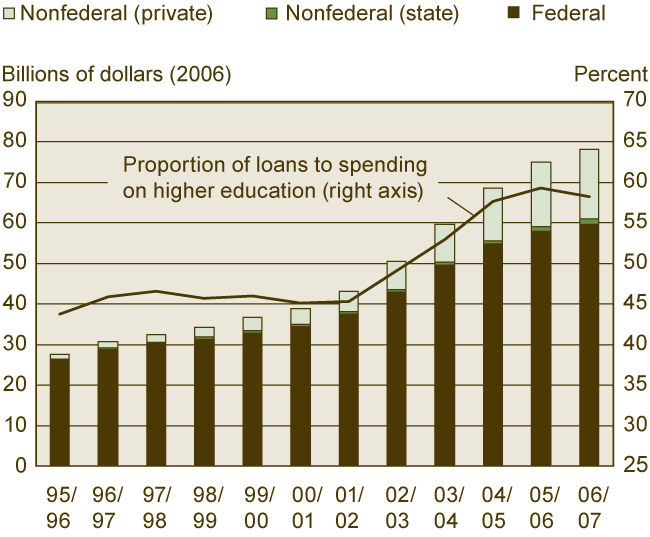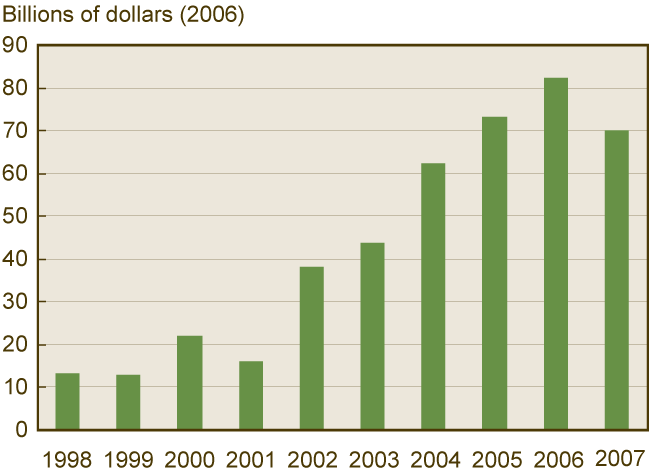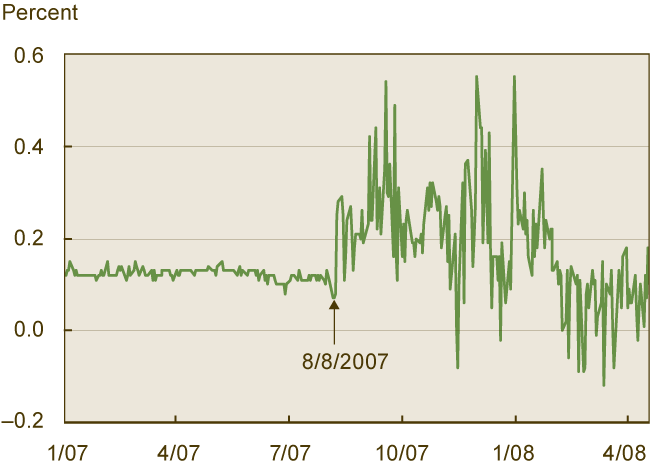- Share
Trouble Ahead for Student Loans?
The market for student loans may differ in some respects from other financial markets, but private lenders are the primary source of funds. As in other markets, the incentive to lend those funds comes from the ability to make a profit. But recent turmoil in financial markets is affecting all of the factors that contribute to the profitability of student loans, leading to speculation that the availability of such loans will fall.
The views authors express in Economic Commentary are theirs and not necessarily those of the Federal Reserve Bank of Cleveland or the Board of Governors of the Federal Reserve System. The series editor is Tasia Hane. This paper and its data are subject to revision; please visit clevelandfed.org for updates.
Spring is a stressful time for college-bound high school seniors and their parents. Those who receive the thick envelope from colleges do not always have a thick wallet to pay their way through college. Thus they join the late-spring ritual of applying for student loans. The reliance on student loans to pay tuition and other expenses is what makes the student loan industry an integral part of our higher education system. For many students, getting approved for a loan is just as important as getting accepted into a good school.
Unfortunately, the turmoil that has shaken up our financial markets since 2007 is arousing some concern that fewer student loans will be available for the 2008–2009 academic year or that interest rates will climb. In testimony before the U.S. Senate Committee on Banking, Housing, and Urban Affairs (April 15, 2008), Mark Kantrowitz, publisher of the financial aid website, FinAid, estimated that 57 lenders have suspended participation in the federal student loan program, and 19 have suspended private student loan programs. These lenders represent about 13 percent of fiscal-year 2006 federally insured private loan volume, and 67 percent of fiscal-year 2006 consolidation loan volume.
Concerns about loan availability have brought the once-obscure student loan market to the front pages of financial newspapers. Knowing how the market is structured provides some insight into how it is being affected by current financial conditions. A number of trends are working to decrease the profit that private lenders, who supply most of the funds to the market, can make.
Nuts and Bolts of the Student Loan Market
The student loan industry is a significant source of funding for college students. In recent years, annual loan originations have been in the $70 billion–$80 billion range, which is more than half of U.S. households’ annual spending on higher education ($134 billion in 2006) (see figure 1). In parallel with rapidly rising college costs, the industry has seen an average annual growth rate of 10 percent between the 1995–96 and 2006–07 school years.
Figure 1. Student Loan Volume

Sources: Bureau of Economic Analysis; Haver Analytics.
There are four major types of higher-education loans: those made through federal programs to students, those made through federal programs to parents, private loans, and consolidated loans. State loans are also available, but they comprise a negligible portion of the market. Stafford and Perkins loans are the two types of federal loan programs available to students. Perkins loans are funded by the U.S. Department of Education with the school acting as the lender (doing the paperwork), and Stafford loans are originated either by private lenders using private funding sources or directly by the U.S. Department of Education using federal sources. Perkins loans and both types of Stafford loans provide a low and fixed interest rate to students up to a borrowing limit. All are insured by the federal government against default. The government also has to provide a significant subsidy to private lenders in the federal student loan program, in order to make it an attractive business proposition.
PLUS loans are offered through a federal program to the parents of undergraduates and directly to graduate students. They can be used to cover the difference between full college costs and subsidized student loan borrowing limits. Just like Stafford loans, PLUS loans can either be made with private or government funding sources. However, unlike Stafford loans, the interest rate is not subsidized while the student is in school. Also, to qualify for PLUS loans, parents must have a good credit history and must not be in default on any federal student loan.
Private loans are basically unsecured loans arranged directly between borrowers and lenders. Because they lack federal guarantees and subsidies, they are the most costly type of loan. Loan approval and borrowing-limit decisions are based upon a particular borrower’s risk profile (credit score and cohort default rate of the institution attended). Instead of low, fixed interest rates, private loans are tied to either the prime rate (for most creditworthy borrowers) or the LIBOR (London interbank offered rate, the rate of at which banks offer to lend money to each other in the London wholesale money markets), plus a margin.
Finally, consolidation loans are made by both private lenders and the government. They offer borrowers the opportunity to combine multiple loans into one, larger loan under a single lender, between the time a student’s studies are completed and loans are repaid. The interest rate of the consolidated loan is set at the weighted average of the interest rates of each loan being consolidated, with a maximum rate of 8.25 percent. Beyond the convenience of having fewer lenders to pay each month, student loan consolidations are advantageous to students because in many cases, they have longer maturities and smaller monthly payments.
Three features of the market are important for understanding its current troubles. First, private lenders play a critical role in this market. They supply about 80 percent of the $55 billion–$60 billion in new federal loans made each year. An additional $15 billion–$20 billion is funded by private lenders in the form of private loans. The exit of private lenders from the student loan market could mean that fewer student loans will be available.
Second, market share in the student loan market is highly concentrated. While it is commonly cited that over 2,000 lenders participate in the federal loan program, the reality is that 91.5 percent of new Stafford and PLUS loans and 99.8 percent of consolidated loans are originated by only 100 lenders, according to the Department of Education and FinAid.org. While the number of lenders exiting the market so far (57 as of April 2008) is small relative to the total number of lenders, the impact of their departure could be substantial, given that those leaving are among the top lenders.
The third important feature of the student loan market is that it is highly securitized. As figure 2 shows, the number of new student loans being securitized into student-loan-asset-backed securities (SLABS) saw steady growth in recent years, until 2007. In 1998 the annual student loan market was about $40 billion, with about $12 billion of it, or 30 percent, being securitized. By 2006, those figures jumped to about $75 billion in new loans, with about $82 billion in new securitizations—or over 100 percent (annual securitizations can exceed the annual origination of new loans because new securitizations may include seasoned loans on the balance sheet). These numbers suggest that in recent years, the securitization market has become the main artery through which funds are channeled from investors to students.
Figure 2. SLABS Issuance

Source: Moody’s.
Stafford loans obtained through private lenders offer very attractive pricing terms to students. The interest rate is fixed and capped at 6.8 percent even though the lenders’ cost of funds will vary with the market rates. To compensate lenders, the federal government insures 97 percent of the loan against default and pays the lenders a two-part subsidy that varies with the lenders’ funding costs. The first part varies with the 90-day financial commercial paper rate, and the second part is a fixed mark-up rate (called a special allowance payment, or SAP). The SAP—the interest paid by the federal government to the lender to supplement the interest paid by the student—is currently set at 1.19 percent.
The variable subsidy, which depends on commercial paper rates, is intended to track the changes in lenders’ short-term funding costs. Actually, lenders’ funding costs mostly follow the LIBOR, but commercial paper rates have traditionally been considered a close substitute for subsidy purposes because both rates have tracked each other very closely in recent years.
While LIBOR-based funding is highly popular, it meets about two-thirds of the lenders’ liquidity needs. The other third of the market has traditionally been funded through the auction-rate securities market. The securities traded in this market are intermediate- to long-term bonds whose interest payments are periodically reset through an auction process in which the buyers and sellers of the bonds determine the market-clearing interest rate—the rate at which the supply of bonds from the sellers equals the demand by potential buyers. Recent Events and the Student Loan Market According to industry experts, the period of rapid student loan growth seems to be over, yet college costs are not expected to level off or decrease. The quick—and common-sense—explanation is that this market must no longer be profitable.
We have discussed six factors that affect the profitability of student loans: the fixed rate paid by the students, the federal insurance, the mark-up (SAP), the LIBOR, the commercial paper rate, and the auction-rate securities market. A change in any of these factors could reduce lenders’ profitability and cause them to exit from the Stafford student loan program. As it turns out, all six factors changed in the direction that would hurt the profitability and availability of student loans.
First, the auction-rate securities market failed during the financial turmoil, as investors preferred to put their money only in the safest securities. As a result, a third of lenders’ funding sources for the student loan market disappeared. The other two-thirds, which comes from the securitization market, shrank rapidly as well. Interest rates in the securitization market are tied to the LIBOR, and the LIBOR’s numerous spikes since August 2007 have made it unprofitable for lenders to raise funds in the LIBOR market and lend them to students at low, fixed rates.
Next, the close connection between the LIBOR and the commercial paper rate broke down during the first days of the crisis (figure 3), with the LIBOR increasing much more rapidly than the commercial paper rate. Because one part of the federal subsidy paid to lenders is tied to the commercial rate, this meant that lenders’ funding costs grew much more quickly than the subsidy they were getting from the government.
Figure 3. LIBOR and Commercial Paper Spread

Note: The spread is the three-month LIBOR rate minus the three-month financial commercial paper rate.
Sources: The Board of Governors of the Federal Reserve System; Financial Times.
The severity of the problem was probably heightened by the reduction of subsidies caused by the College Cost Reduction and Access Act of 2007. While before October 1, 2007, the government insured 98 percent of the loans’ face value, the limit declined to 97 percent after that date and will decline to 95 percent by 2012. The same Act also cut the mark-up (SAP) for various types of loans as much as 85 basis points (figure 4). Finally, the law stipulated a reduction in the 6.8 percent cap on student loan rates to an ultimate low of 3.4 percent over the next few years.
Figure 4. SAP Rate: Margin Earned above Financial Commercial Paper
| Pre-October 2007 | Post-October 1, for-profit originators | Post-October 1, not-for-profit originators | |
|---|---|---|---|
| Stafford, during grace or deferment | 1.74 | 1.19 | 1.34 |
| Stafford, during repayment | 2.34 | 1.79 | 1.94 |
| Plus | 2.64 | 1.79 | 1.94 |
| Consolidation | 2.64 | 2.09 | 2.24 |
Source: Moody’s.
Looking Ahead
It seems like the student loan market was hit by a number of significant shocks. Funding costs and credit risk have gone up, revenues and subsidies have come down. The policy response will require determining the extent to which each of these factors is contributing to any contraction in student loans in the coming academic year. Unfortunately, there is not enough information at this time to disentangle the individual effect of each of these factors on the student loan market.
On the bright side, PLUS loans and private loans may make up for fewer Stafford loans. However, in addition to being more expensive, these alternatives have stringent credit history requirements and may not be available to those with low incomes and tainted credit histories. Efforts to mitigate the symptoms of a shrinking student loan pool are underway at the federal level. For example, the federal government will add liquidity to the market by buying student loans from lenders. The Department of Education will also increase the size of its Stafford lending to make up for the shortfall from private lenders exiting the program, at a total net cost of $240 million. Efforts such as these should buy policymakers sufficient time to devise a more permanent solution to the problem.
Recommended Reading
- Footing the Tuition Bill: The New Student Loan Sector. 2007. Edited by Frederick M. Hess. AEI Press: Washington, DC.
- “Solving the Student Loan Credit Crunch,” by Mark Kantowitz. 2008. Published on FinAid, a website of resources for student financial aid. www.finaid.org/loans/creditcrisis.phtml.
This work by Federal Reserve Bank of Cleveland is licensed under Creative Commons Attribution-NonCommercial 4.0 International




